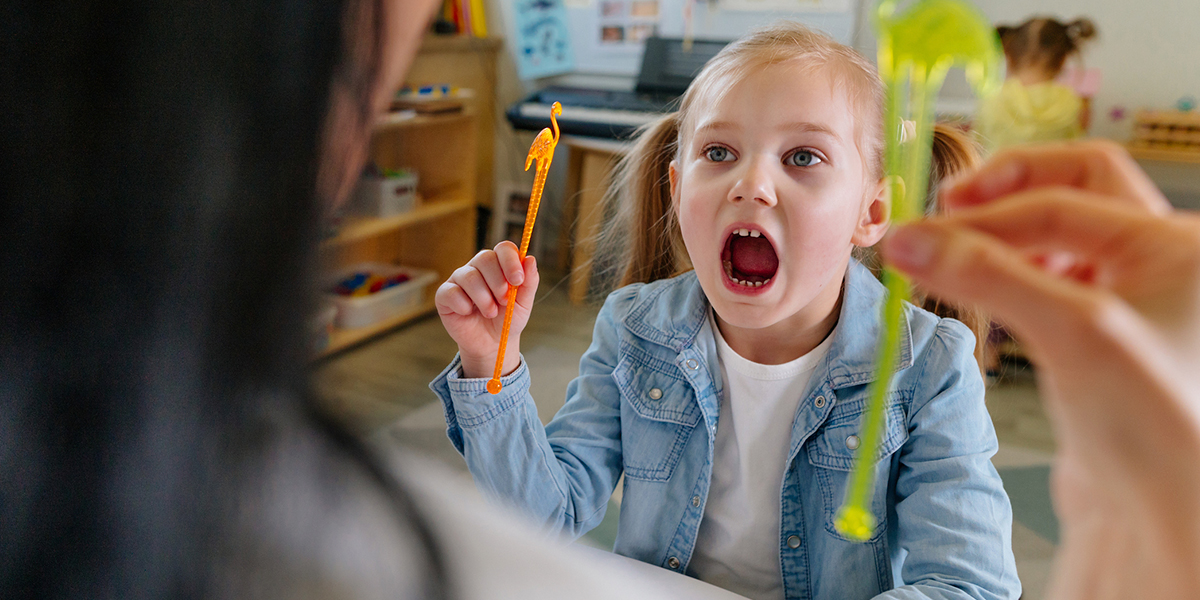9 Speech-Language Disorders Commonly Diagnosed in Kids
Although every child will develop differently, there are times when a kid presents language challenges that may indicate a diagnosable disorder is present. In these scenarios, your child may have a speech or language — or both — disorder. Some of the most common speech disorders for kids include:
1. Preschool Language Disorders
By preschool, children should have certain parts of language mastered. However, every child is different, and no two will progress the same. If your preschool-aged child faces several speech-language challenges, they could have a disorder.
There are two major speech disorders associated with preschool age:
- Receptive: Receptive language skills help children understand what is being said to them. These include gestures like nodding or shrugging, pointing to objects, following directions and understanding questions.
- Expressive: The skills associated with expressive disorders are related to talking. These include speaking, using gestures, naming objects or letters, singing and making sentences.
Many conditions — including hearing loss, autism and cerebral palsy, among others — can cause preschool language disorders.
2. Apraxia of Speech (AOS)
AOS causes disruptions in a child’s brain and speech functions. One common way it presents is when a child knows what they want to say, but their brain does not send the right messages to the speech muscles so they can say it. You might notice this if a child can write down their feelings or thoughts but cannot speak them.
AOS can vary between children, meaning yours may only have challenges with certain speech sounds or have difficulty speaking most of the time.
3. Mixed Receptive-Expressive Language Disorder
Developmental challenges cause mixed receptive-expressive language disorder. Traumatic head injuries and seizures may also facilitate this disorder. Kids with this disorder might have symptoms like:
- Struggling to form sentences
- Having a limited vocabulary
- Using the incorrect word tense consistently
Mixed receptive-expressive language disorder affects a child’s ability to understand and express language.
4. Lisps
There are multiple types of lisps, making it crucial to know what to look for. Lisp types include:
- Dental lisp: This lisp occurs when the tongue pushes the front teeth, producing a “muffled” effect of “S” and “Z” sounds.
- Palatal lisp: Palatal lisps are less common. They occur when the tongue’s center touches the roof of a child’s mouth or soft palate when creating “S” sounds.
- Interdental lisp: Interdental lisps are common among children. With these lisps, the child’s tongue will push forward between their front teeth, producing an “S” or “Z” sound that resembles “TH.”
- Lateral lisp: Air that exits the sides of the mouth makes speech sound wet or slushy, resulting in a lateral lisp.
Children ages four and older with one of these lisps may need the help of a speech-language pathologist.
5. Selective Mutism
Selective mutism occurs when children only speak in certain situations. Children may do this for several reasons, including anxiety and speech-language disorders or sensory integration dysfunction.
Selective mutism often starts between two and four years old and can last through adulthood without treatment. Kids with this disorder are not deliberately choosing not to speak but are physically incapable of doing so in these situations. Symptoms of selective mutism include:
- Overcome with a sudden stillness or frozen facial expressions
- Avoiding eye contact
- Feeling or appearing overly stiff or uncoordinated
- Coming off as sulky, disinterested or socially awkward
In some cases, your child may be unable to speak but can use gestures, though this is not present in all children.
6. Dysarthria
Damage to the nerves and muscles in the tongue, diaphragm or lips causes dysarthria. This condition can develop before birth or come after, often due to other medical conditions like cerebral palsy or muscular dystrophy. Common symptoms associated with dysarthria include:
- Unusual speech rhythm
- Slowed or slurred speech
- Pitch changes while speaking
- Reduced lip, tongue or jaw movement
- Altered speech volume
- Monotone speech
Children usually have developmental dysarthria, which occurs due to brain damage either before or during birth. Sometimes, a child could have acquired dysarthria due to stroke, brain tumors or severe head injuries.
7. Speech Sound Disorder
Speech sound disorder is an articulation or phonological disorder. If your child has this condition, they will have challenges producing clear sounds, making it difficult to understand them. Speech sound disorder can have many causes, including:
- Down syndrome
- Autism
- Brain damage
- Cerebral palsy
- Hearing loss
Signs of speech sound disorder include substituting sounds, leaving sounds out altogether or changing sounds.
8. Orofacial Myofunctional Disorder
A child with orofacial myofunctional disorder experiences abnormal development and growth of facial and mouth muscles. The condition can cause challenges with their breathing, talking and eating. Common signs of orofacial myofunctional disorder include:
- Challenges with breathing through the nose
- Mouth breathing
- Underbite or overbite
- Messes while eating
- Drool present after two years of age
Orofacial myofunctional disorder can co-occur with other swallowing and childhood speech disorders.
9. Stuttering
Stuttering is a speech fluency disorder where a child repeats words, syllables or sounds. While many individuals experience moments where they stutter, a child might have a more pressing challenge if it occurs frequently or is only brought on in specific circumstances. Many kids who have a stuttering disorder also experience tics or excessive blinking.
Find Treatment for Common Pediatric Speech Disorders
Speech and language skills are essential for children to learn to communicate their thoughts and feelings, improve their relationships, and have better self-esteem. If you believe your child has a disorder, TLC Pediatric Therapy, part of the Kids SPOT Family of Companies, is ready to help by identifying common speech-language diagnoses for kids and providing individualized speech therapy sessions. Contact us online to schedule an appointment!

